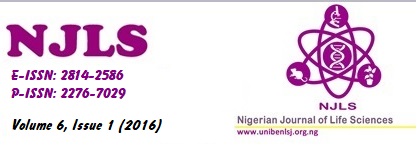SEROPREVALENCE OF HEPATITIS A VIRUS INFECTION AMONG ANTIRETROVIRAL TREATMENT–NAIVE HIV PATIENTS IN BENIN CITY, NIGERIA.
DOI:
https://doi.org/10.52417/njls.v6i1.296Keywords:
Hepatitis A virus, treatment-naive, HIV, NigeriaAbstract
Human immunodeficiency virus (HIV)-infected persons are at increase risk of
Hepatitis A virus (HAV) infection. Against the background of no data on the
prevalence of HAV infection among HIV patients in our environment this study was
conducted. A total of 400 subjects consisting of 200 antiretroviral naive HIV patients
and 200 non–HIV subjects were recruited for this study. Detection of HAV 1gM
antibodies was performed for all subjects while CD4 count was performed for HIV
patients only using standard technique. A structured questionnaire was used to
collect data on demography and risk factors. There was no significant difference in
the prevalence of HAV among HIV patients and their non–HIV counterpart (P =
0.7030). CD4 count < 200 cells/ul was not significantly associated with HAV infection
among the HIV patients (OR = 0.195 95% CI = 0.010, 3.678; P = 0.3315). Level of
education was the only demography that significantly affected the prevalence of HAV
infection (P < 0.0001) with patients with no formal education having the highest
prevalence (40.00%). HIV patients who travelled to HAV endemic countries are
significantly more likely to be seropositive for HAV infection (OR = 38.200 95% CI
= 4.440, 328.68; P = 0.0002) while other risk factors did not significantly affect the
seroprevalence of HAV infection among HIV patients (P > 0.05). An overall
seroprevalence of 2.00% of acute HAV infection was observed among HIV patients
in this study. Measures to reduce or eliminate HAV infection among HIV patients are
advocated.

Published
Issue
Section
License
Copyright (c) 2016 https://www.unibenlsj.org.ng/index.php/njls

This work is licensed under a Creative Commons Attribution 4.0 International License.





